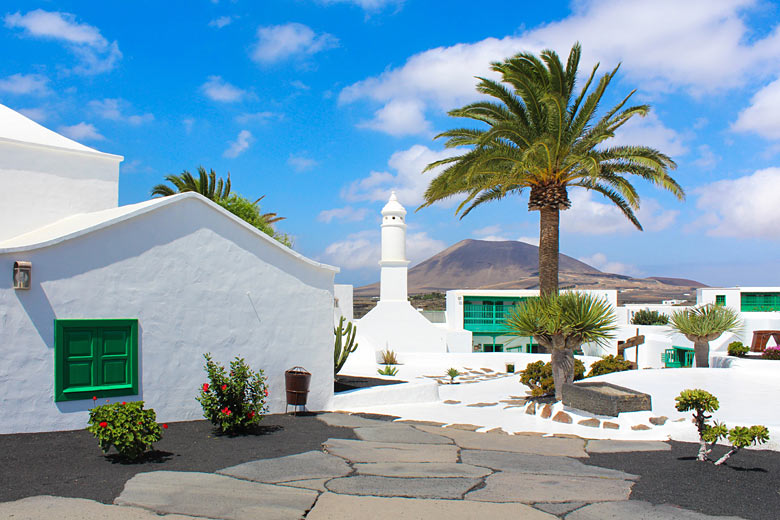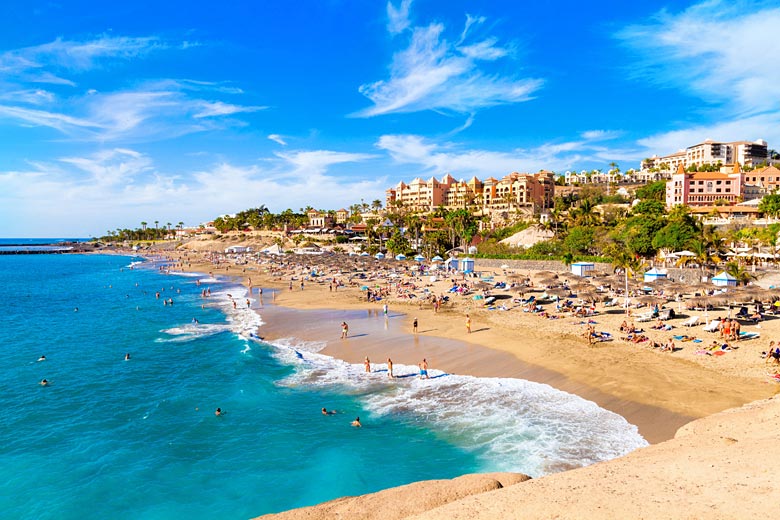- Book online with TUI & save up to 8% on holidays
- FREE child places available for select holidays
- Pay £0 deposits with direct debit & spread the cost
Spain weather by month
Check out Spain weather averages by month. Compare detailed monthly climate statistics including temperature, rainfall and sunshine figures.
| Jan | Feb | Mar | Apr | May | Jun | Jul | Aug | Sep | Oct | Nov | Dec | |
|---|---|---|---|---|---|---|---|---|---|---|---|---|
| Maximum daytime temperature °F |  50 50 |
 54 54 |
 59 59 |
 64 64 |
 72 72 |
 82 82 |
 90 90 |
 90 90 |
 81 81 |
 68 68 |
 57 57 |
 50 50 |
| Hours of sunshine (daily) | ||||||||||||
| Days with some rainfall |  14 14 |
 13 13 |
 12 12 |
 12 12 |
 11 11 |
 8 8 |
 5 5 |
 4 4 |
 7 7 |
 11 11 |
 12 12 |
 14 14 |
More about Spain
Spain by month
Jan Feb Mar Apr May Jun Jul Aug Sep Oct Nov Dec
Recommended for Spain
The climate guide for Spain (Madrid) shows long term monthly weather averages processed from data supplied by CRU (University of East Anglia), the Met Office & the Netherlands Meteorological Institute. Find out more about our data sources.
Top Spain destinations
Below are average maximum temperatures at popular countries, regions and places in Spain for next month - August. Select a destination to see the climate guide for all months of the year.
- Seville
- Madrid
- Alicante
- Nerja
- Benidorm
- Costa Almeria
- Costa Blanca
- Costa del Sol
- Malaga
- Valencia
- Benalmadena
- Costa de la Luz
- Ibiza
- Majorca
- Torremolinos
- Costa Brava
- Costa Dorada
- Lanzarote
- Menorca
- Palma
- Barcelona
- Fuerteventura
- Gran Canaria
- Tenerife
Spain regions
All Spain regions
- Balearic Islands
- Canary Islands
- Costa Almeria
- Costa Blanca
- Costa Brava
- Costa de la Luz
- Costa del Sol
- Costa Dorada
- El Hierro
- Formentera
- Fuerteventura
- Gran Canaria
- Ibiza
- La Gomera
- La Palma
- Lanzarote
- Majorca
- Menorca
- Tenerife
All Spain destinations
A B C D E F G H I J K L M N O P Q R S T U V W X Y Z
A
- Adeje, Tenerife
- Adra, Costa Almeria
- Agaete, Gran Canaria
- Aguadulce, Costa Almeria
- Aguimes, Gran Canaria
- Alaior, Menorca
- Albacete
- Albir, Costa Blanca
- Alcoceber
- Alcudia, Majorca
- Alfaz del Pi, Costa Blanca
- Algarrobo, Costa del Sol
- Algeciras, Costa de la Luz
- Alicante, Costa Blanca
- Almeria, Costa Almeria
- Almerimar, Costa Almeria
- Almunecar, Costa del Sol
- Altafulla, Costa Dorada
- Altea, Costa Blanca
- Arenal d'en Castell, Menorca
- Arguineguin, Gran Canaria
- Arona, Tenerife
- Arrecife, Lanzarote
- Arta, Majorca
- Arucas, Gran Canaria
B
- Badajoz
- Bahia Feliz, Gran Canaria
- Barcelona
- Begur, Costa Brava
- Benahavis, Costa del Sol
- Benalmadena, Costa del Sol
- Benicassim
- Benidorm, Costa Blanca
- Bilbao
- Binibeca, Menorca
- Blanes, Costa Brava
C
- Cabo Blanco, Majorca
- Cadiz, Costa de la Luz
- Cala Blanca, Menorca
- Cala Bona, Majorca
- Cala d'Alcaufar, Menorca
- Cala d'Or, Majorca
- Cala de San Vincente, Majorca
- Cala en Blanes, Menorca
- Cala en Forcat, Menorca
- Cala en Porter, Menorca
- Cala Galdana, Menorca
- Cala Gracio, Ibiza
- Cala Llenya, Ibiza
- Cala Llonga, Ibiza
- Cala Mandia, Majorca
- Cala Mayor, Majorca
- Cala Mesquida, Majorca
- Cala Millor, Majorca
- Cala Morell, Menorca
- Cala Ratjada, Majorca
- Cala Santandria, Menorca
- Cala Santanyi, Majorca
- Cala Vadella, Ibiza
- Cala Vinas, Majorca
- Calafell, Costa Dorada
- Calahonda, Costa del Sol
- Calan en Bosc, Menorca
- Calas de Mallorca, Majorca
- Calella, Costa Brava
- Calella de Palafrugell, Costa Brava
- Caleta de Fuste, Fuerteventura
- Callao Salvaje, Tenerife
- Calpe, Costa Blanca
- Cambrils, Costa Dorada
- Camp de Mar, Majorca
- Can Pastilla, Majorca
- Can Picafort, Majorca
- Canyamel, Majorca
- Carboneras, Costa Almeria
- Cartagena, Costa Blanca
- Casares, Costa del Sol
- Castellon
- Chipiona, Costa de la Luz
- Ciudad Jardin, Majorca
- Ciudad Real
- Ciutadella, Menorca
- Colonia Sant Jordi, Majorca
- Coma Ruga, Costa Dorada
- Conil, Costa de la Luz
- Cordoba
- Corralejo, Fuerteventura
- Costa Adeje, Tenerife
- Costa Antigua, Fuerteventura
- Costa Calma, Fuerteventura
- Costa del Silencio, Tenerife
- Costa Teguise, Lanzarote
- Cruz de Tejeda, Gran Canaria
D
E
- Ejido, Costa Almeria
- El Arenal, Majorca
- El Campello, Costa Blanca
- El Cotillo, Fuerteventura
- El Gastor, Costa del Sol
- El Medano, Tenerife
- El Paso, La Palma
- El Rompido, Costa de la Luz
- El Sauzal, Tenerife
- El Toro, Majorca
- Elche, Costa Blanca
- Empuriabrava, Costa Brava
- Es Cana, Ibiza
- Es Canutells, Menorca
- Es Castell, Menorca
- Es Figueral, Ibiza
- Es Mercadal, Menorca
- Estartit, Costa Brava
- Estepona, Costa del Sol
F
- Ferreries, Menorca
- Figueres, Costa Brava
- Figueretas, Ibiza
- Frigiliana, Costa del Sol
- Frontera, El Hierro
- Fuencaliente, La Palma
- Fuengirola, Costa del Sol
G
- Garachico, Tenerife
- Girona, Costa Brava
- Golf del Sur, Tenerife
- Granada
- Guardamar del Segura, Costa Blanca
- Guia de Isora, Tenerife
H
- Huelva, Costa de la Luz
I
- Ibiza Town, Ibiza
- Illetes, Majorca
- Isla Canela, Costa de la Luz
- Isla Cristina, Costa de la Luz
- Islantilla, Costa de la Luz
J
L
- L'Ametlla de Mar, Costa Dorada
- La Asomada, Lanzarote
- La Cala Finestrat, Costa Blanca
- La Caleta, Tenerife
- La Coruna
- La Manga, Costa Blanca
- La Pineda, Costa Dorada
- La Selva del Camp, Costa Dorada
- La Vagueta, Lanzarote
- Las Caletillas, Tenerife
- Las Canteras, Gran Canaria
- Las Palmas, Gran Canaria
- Las Playitas, Fuerteventura
- Leon
- Llafranc, Costa Brava
- Lloret de Mar, Costa Brava
- Llucmajor, Majorca
- Los Cancajos, La Palma
- Los Cristianos, Tenerife
- Los Gigantes, Tenerife
- Los Llanos, La Palma
- Los Valles, Lanzarote
M
- Madrid
- Magalluf, Majorca
- Mahon, Menorca
- Malaga, Costa del Sol
- Malgrat de Mar, Costa Brava
- Manilva, Costa del Sol
- Marbella, Costa del Sol
- Maspalomas, Gran Canaria
- Matagorda, Lanzarote
- Meloneras, Gran Canaria
- Miami Playa, Costa Dorada
- Mijas, Costa del Sol
- Mojacar, Costa Almeria
- Moraira, Costa Blanca
- Morro Jable, Fuerteventura
- Mount Teide, Tenerife
- Murcia, Costa Blanca
N
- Nerja, Costa del Sol
- Novo Sancti Petri, Costa de la Luz
- Nuevo Horizonte, Fuerteventura
O
P
- Paguera, Majorca
- Pajara, Fuerteventura
- Palamos, Costa Brava
- Palma, Majorca
- Palma Nova, Majorca
- Pamplona
- Patalavaca, Gran Canaria
- Peniscola
- Pilar de la Horadada, Costa Blanca
- Pineda de Mar, Costa Brava
- Playa Amadores, Gran Canaria
- Playa Blanca, Lanzarote
- Playa d'Aro, Costa Brava
- Playa d'en Bossa, Ibiza
- Playa de Esquinzo, Fuerteventura
- Playa de Fanabe, Tenerife
- Playa De Fornells, Menorca
- Playa de Jandia, Fuerteventura
- Playa de la Arena, Tenerife
- Playa de las Americas, Tenerife
- Playa de los Pocillos, Lanzarote
- Playa de Muro, Majorca
- Playa de Palma, Majorca
- Playa de Pals, Costa Brava
- Playa de San Juan, Costa Blanca
- Playa de Santiago, La Gomera
- Playa del Cura, Gran Canaria
- Playa del Ingles, Gran Canaria
- Playa Honda, Lanzarote
- Playa Mogan, Gran Canaria
- Playa Paraiso, Tenerife
- Playa Taurito, Gran Canaria
- Port d'Andratx, Majorca
- Port de Pollensa, Majorca
- Port des Torrent, Ibiza
- Portals Nous, Majorca
- Portaventura, Costa Dorada
- Portinatx, Ibiza
- Porto Colom, Majorca
- Porto Cristo, Majorca
- Porto Petro, Majorca
- Puerto Alcudia, Majorca
- Puerto Banus, Costa del Sol
- Puerto Calero, Lanzarote
- Puerto de la Cruz, Tenerife
- Puerto de la Duquesa, Costa del Sol
- Puerto de Mazarron, Costa Blanca
- Puerto de Santiago, Tenerife
- Puerto del Carmen, Lanzarote
- Puerto del Rosario, Fuerteventura
- Puerto Naos, La Palma
- Puerto Rico, Gran Canaria
- Puerto San Miguel, Ibiza
- Punta Prima, Menorca
- Punta Umbria, Costa de la Luz
R
- Retamar, Costa Almeria
- Reus, Costa Dorada
- Rincon de la Victoria, Costa del Sol
- Ronda, Costa del Sol
- Roquetas de Mar, Costa Almeria
- Roses, Costa Brava
- Rota, Costa de la Luz
S
- S'Agaro, Costa Brava
- S'Algar, Menorca
- S'argamassa, Ibiza
- S'Illot, Majorca
- Sa Caleta, Ibiza
- Sa Coma, Majorca
- Sa Pobla, Majorca
- Salamanca
- Salobre Golf, Gran Canaria
- Salou, Costa Dorada
- San Agustin, Gran Canaria
- San Antonio, Ibiza
- San Antonio Bay, Ibiza
- San Bartolome, Lanzarote
- San Bartolome de Tirajana, Gran Canaria
- San Feliu de Guixols, Costa Brava
- San Isidro, Tenerife
- San Jose, Costa Almeria
- San Jose, Ibiza
- San Juan, Ibiza
- San Juan de Alicante, Costa Blanca
- San Mateo, Gran Canaria
- San Miguel, Ibiza
- San Miguel, Tenerife
- San Pedro de Alcantara, Costa del Sol
- San Sebastian
- San Sebastian de la Gomera, La Gomera
- Sant Lluis, Menorca
- Sant Tomas, Menorca
- Santa Brigida, Gran Canaria
- Santa Cruz de la Palma, La Palma
- Santa Cruz de Tenerife, Tenerife
- Santa Eulalia, Ibiza
- Santa Pola, Costa Blanca
- Santa Ponsa, Majorca
- Santa Susanna, Costa Brava
- Santa Ursula, Tenerife
- Santander
- Santanyi, Majorca
- Santiago de Compostela
- Seville, Costa de la Luz
- Sitges, Costa Dorada
- Soller, Majorca
- Son Bou, Menorca
- Son Caliu, Majorca
- Son Parc, Menorca
- Son Servera, Majorca
T
- Talamanca, Ibiza
- Tamariu, Costa Brava
- Tarifa, Costa de la Luz
- Tarragona, Costa Dorada
- Tazacorte, La Palma
- Tias, Lanzarote
- Toledo
- Torre del Mar, Costa del Sol
- Torremolinos, Costa del Sol
- Torrevieja, Costa Blanca
- Torroella de Montgri, Costa Brava
- Torrox Costa, Costa del Sol
- Tortosa, Costa Dorada
- Tossa de Mar, Costa Brava
V
- Valencia
- Valladolid
- Valldermossa, Majorca
- Valle Gran Rey, La Gomera
- Valverde, El Hierro
- Vera, Costa Almeria
- Vigo
- Vilaflor, Tenerife
- Villajoyosa, Costa Blanca
Y
- Yaiza, Lanzarote
Z
Metric (°C) | Imperial (°F)
Spain climate overview
Spain occupies most of the Iberian Peninsula at the western extremity of the European mainland. Its urban attractions range from the grand and cosmopolitan cities of Madrid and Barcelona, to atmospheric Mediterranean towns and cities with their history of Roman settlement, and more evident remains of the Moorish occupation.
Central Spain is dominated by a vast central elevated plateau. This is heavily dissected by river gorges into several rugged sierras. The natural vegetation high up on the plains is little more than arid scrub, but pine forests and deciduous woodland cling to river valleys and gorges below.
The soils are generally poor but do support crops of wheat and barley. Mainly because of its altitude, Spain's interior has cold winters with showers and snow flurries, contrasting with hot dry summers.
The Pyrenees are the highest mountains in Spain and lie along its northern border with France. The sheer magnitude of the scenery is spectacular with a mixture of desolate scree and pockets of pine forest. Frequent and heavy winter snowfall is often accompanied by cloud and high winds. The summers are much drier with plenty of sun and warm temperatures.
The lowland plains of Spain adjacent to both Mediterranean and Atlantic coastlines support extensive agriculture. In the south this ranges from olives and oranges to vegetables and fruit for northern European supermarkets. Except at higher elevations wine is produced almost everywhere. The Atlantic coast is the wettest part of the country with rain throughout the year, cool winters and warm summers.
The Mediterranean coast including the Balearic Islands of Majorca, Menorca and Ibiza has a much drier climate with hardly any rain in the summer months. This makes the Balearic Islands, Costa Brava, Costa Blanca, and the Costa del Sol among the most popular holiday destinations in all of Europe with most resorts enjoying at least 10 hours of sunshine per day at the height of summer.
The Canary Islands, lying off the coast of Africa 1,500 kilometres (825 miles) to the south-west, are also part of Spain. Summers on these volcanic islands are actually cooler than on the Spanish mainland because of the surrounding ocean. However, being that much further south, the climate in winter is far milder with temperatures at sea level hardly ever falling below 10°C, even at night. What little rain there is here falls during the winter months from November to March.
More about Spain
Compare Spain with the UK
Below the Spain chart shows average maximum daytime temperature for Spain (Madrid) and the UK (London).
Maximum daytime temperature (°F)
Metric (°C) | Imperial (°F)
Be inspired
Get your weekly fix of holiday inspiration from some of the world's best travel writers plus save on your next trip with the latest exclusive offers
We promise not to share your details
Related posts
Popular travel offers
Explore holidays in the sun for less
- Beach holidays
- Family holidays
- City breaks
- Summer holidays
- Winter sun holidays
- Holiday offers
- Top travel brands
- Airlines & flights
- Discount hotels
- Airport parking deals
- TUI
- Jet2holidays
- easyJet holidays
- Love Holidays
- January sales
Airport parking
- Manchester Airport
- Stansted Airport
- Bristol Airport
- Luton Airport
- Birmingham Airport
- Edinburgh Airport
- Gatwick Airport
- Glasgow Airport
- Newcastle Airport
Airport lounges
- Manchester Airport
- Birmingham Airport
- Bristol Airport
- Edinburgh Airport
- Glasgow Airport
- Heathrow Airport
- Newcastle Airport
- Stansted Airport
- Gatwick Airport



















 TUI deal finder
TUI deal finder




